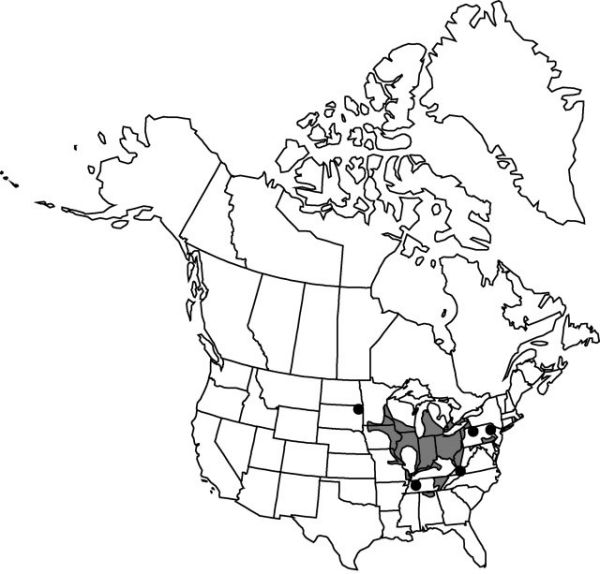Trillium flexipes
Autik. Bot., 133. 1840.
Rhizomes somewhat erect, thick, praemorse. Scapes 1–several from single rhizome, round in cross section, 2–5 dm, glabrous. Bracts sessile; blade medium green without red or maroon undertones, rhombic, 7–25 × 7–25 cm, frequently wider than long, base attenuate from just above middle, apex acuminate. Flower flexed ca. 90° on summit of pedicel to face outward rather than upward, or variously carried on strongly declined pedicels; sepals weakly recurved, green, lanceolate, 14–45 mm, shorter than or barely equaling petals, margins entire, apex acuminate; petals flat or recurved in distal 1/2, creamy white, not 2-colored, veins conspicuously engraved, ovate-lanceolate to broadly ovate, 2–5 × 1–4 cm, texture heavy, margins entire, apex acute; stamens large, ± erect, 9–23 mm; filaments white, less than 1/2 anther length, thin; anthers straight or very slightly recurving, creamy white or yellow, 5–18 mm, thick, dehiscence ± introrse; ovary white, ovoid to flask-shaped, strongly 6-angled, 5–16 × 4–12 mm, widely attached basally; stigmas recurved, distinct but closely grouped, white, not lobed adaxially, linear-subulate, short, thick, 4–13 mm, ± equaling ovary, fleshy; pedicel stiffly erect, carried horizontally, or declined beneath bracts, rarely recurved, 4–12 cm. Fruits baccate, rosy red to purplish, fragrant of ripe fruit, ovoid to somewhat pyramidal at summit, strongly angled, 2–3.5 × 1–3 cm, very juicy at maturity. 2n = 10.
Phenology: Flowering spring (Apr–early Jun).
Habitat: Rich wooded slopes, floodplains in deciduous forests, especially over limestone
Elevation: 100–600 m
Distribution

Ont., Ala., Del., Ill., Ind., Iowa, Ky., Mich., Minn., Mo., N.Y., Ohio, Pa., S.Dak., Tenn., Va., W.Va., Wis.
Discussion
Although there are no named varieties of Trillium flexipes, many forms exist and at least one has been named, forma walpolei (Farwell) Fernald. F. W. Case and G. L. Burrows (1962) mapped the occurrence of forma walpolei for Michigan and found it to occur only along the contact zone between T. flexipes and T. erectum. F. W. Case and R. B. Case (1993) crossed typical T. erectum and T. flexipes to produce identical color variations as occur in these wild, mixed-species populations. I consider this form to be a hybrid expression. Some of the hybrids have petals colored proximally and white distally, superficially resembling T. undulatum. Dried specimens, when hastily examined, resemble T. undulatum superficially and probably account for reports of that species from locations near Ann Arbor, Michigan, and various places in Indiana and Illinois, all of which are well out of the range of T. undulatum.
Selected References
None.